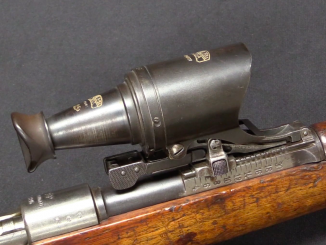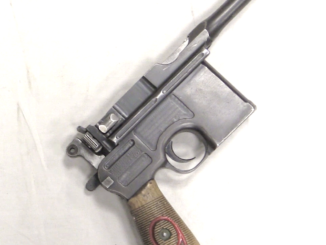The S2-200 was developed by Louis Stange at the Rheinmetall company in Germany in the late 1920s. Because Germany was not allowed to be doing this sort of arms development at the time, Rheinmetall bought a controlling stake in the Swiss firm Solothurn AG, to make the product deniably Swiss. The gun itself is recoil operated, with a rotating locking collar connecting the bolt and barrel, rather like the Hotchkiss Portative. It was a design that had some early influence on the German MG34, although the German military declined to adopt it. Instead, it was taken into service in 8x56mm by both Austria (as the MG30) and Hungary (as the 31M). A third purchaser was El Salvadore, which purchased 47 examples in 7x57mm caliber.
After the anschluss in 1938, the Austrian guns were integrated into the Wehrmacht, where they were primarily used by mountain troops. Hungary did later make a version in 7.92x57mm, designated the 43M.
Many thanks to the Royal Armouries for allowing me to film and disassemble these two very rare LMGs! The NFC collection there – perhaps the best military small arms collection in Western Europe – is available by appointment to researchers:
https://royalarmouries.org/research/national-firearms-centre/
You can browse the various Armouries collections online here:
https://royalarmouries.org/collection/




“(…)design that had some early influence on(…)MG34(…)”
It also spawned M. G. 15 aircraft machine gun which was widely used in Luftwaffe’s aeroplanes.
“(…)Hungary did later make a version in 7.92x57mm, designated the 43M. (…)”
http://hungariae.com/Soloth.htm claims that said version was both newly-made and rebuilt from older (8×56) examples. It also claims Hungarians manage to craft Solothurn Repülõgép Golyószóró 34/AM which was aircraft machine gun feed from two 75-round detachable drum magazines sporting muzzle booster which increased Rate-of-Fire from 450…500 rpm (of 31.M) to 1000 rpm.
This seems… suspiciously high. Was that (at least +100%) increase done solely by adding said muzzle booster? At what airplanes said gun was used? Why did they bother with developing this machine gun and 1934.M http://hungariae.com/Gebauer.htm (gas-operated, feed from magazine with capacity 100) apparently at same time (around 1934)?
The planes were Hungarian contract Ju 86. It increase cadence from 600-800 to 1000 round per minute. But I never try it )))) so I can not say if it works. I do not have a gun. It weight 458 grams.
sorry …..I am talking about muzzle booster weight 458 grams for 34 AM….for hungarian solothurn aircraft guns….but i think it was possible to mount it on any 31 M
I’m almost certain that the “external sear” bit there was meant to interact with the Lafette mount, providing for a below-sightline triggering option. The “tripod trigger”, if you will, was about 30cm below the gun, and integrated in with the periscopic sight that came with the system.
I believe that there was also a fortress/turret setup that made use of that feature, and gave the gun the option for an external trigger system, using a cable. The designers were not all that stupid so as to created a Type 94 situation; that part was there for a purpose, or it wouldn’t have been there.
Racking my brain to remember where the hell I saw this, right now… I fear it may be lost to time.
https://modernfirearms.net/en/machineguns/switzerland-machineguns/steyr-solothurn-mg-30-eng/ claims that The gun is normally fitted with a folding bipod, although Solothurn also produced a sophisticated universal tripod, with a remote trigger and a traverse and elevation mechanism, and recoil buffers. without giving details how this was done, https://guns.fandom.com/wiki/Steyr-Solothurn_S2-200 shows S2-200 mounted on a spring-loaded tripod.. I suspect reason why Stange elected to use “(…) “external sear” bit(…)” might be hidden in 1 of following patents
https://patents.google.com/patent/DE532370C
https://patents.google.com/patent/DE599849C
but extracting that would required summoning someone who excels at 1920s technical Deutsch.
Daweo, that picture doesn’t look like the one I remember seeing. If you blow up the one you reference, you can see that there’s no connection to the weapon from the tripod where the exposed sear bit is, and there’s some sort of bizarre camera-cable release thing up by the trigger group.
The one I remember seeing had this clamp-like affair that went around the entire receiver where that exposed sear is located, and that also served as the location for the rear trunnion of the tripod traverse and elevation system–Or, so I surmised. Not a hell of a lot of detail, there.
There was also something similar for the weapon to be used in a turret, either fortification or vehicular.
This whole range of Germanic machinegun history isn’t at all well-documented. The need to hide it from the Allied Control Commission and all that? The documentation just isn’t there.
Call me stupid, but every time I see someone squatting behind the iron sights of a machine gun stuck on a tripod, I notice that the gunner is in perfect position to get potted right in the face. A remote trigger combined with a periscope sight can make the machine gunner a harder target to attack. I could be wrong.
You, me, and everyone else with an iota of common sense…
You would not believe how hard it is to communicate to the other 90% of the population why a periscopic sight would be a Really Good Idea(TM).
You can show them a German gun team in action, and they still don’t get it: “Look at how hard that thing is to move… Look how heavy it is!!”
Uhhhh… The gunner isn’t exposed, and the tripod can be adapted to whatever terrain you find that provides cover? Does that make the weight/portability issue worth it?
Minor correction. ON the double trigger, “E” does mean single shot.
OTOH “S” means schnell or rapid-fire/automatic.
The German word “sicher” means “safe” in English.